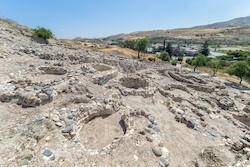Cooperation key to tackling cultural heritage threats
Three projects, all funded through the HERITAGE PLUS (ERA-NET Plus on Cultural Heritage and Global Change Research) project, have successfully applied space technology to monitor the vulnerability of cultural heritage, produced practical manuals on threats for use by governments, global organisations and NGOs, and developed new tools to cost-effectively preserve Europe’s cultural treasures. These EU-funded projects underline the value of bringing together expertise and resources from across Europe to protect our shared European heritage. HERITAGE PLUS is an ERA-NET Plus action coordinated by the Joint Programming Initiative on Cultural Heritage and Global Change (JPI CH). It receives top-up funding from the European Commission to support transnational research projects on topics such as tangible cultural heritage and developing new methodologies, technologies and products for assessing, protecting and managing historical and modern artefacts, buildings and sites. Ms Cristina Sabbioni, one of the JPI CH coordinators, explains, “The HERITAGE PLUS initiative enhances European excellence and competitiveness by developing current knowledge on the challenges facing cultural heritage, to forecast its future change. This is done based on mainstreaming political decisions and on environmental dynamics to understand the impact on tangible, intangible and digital cultural heritage.” Eyes in the sky One such project is Prothego (PROTection of European Cultural HEritage from GeO-hazards), which has, for example, introduced satellite monitoring techniques to analyse geo-hazards at UNESCO World Heritage sites across Europe. These sites, from archaeological complexes to historic town centres, are often impacted by natural hazards such as extreme weather, all of which have been worsened by climate change and human interaction. “A comprehensive picture of sites affected by geo-hazards has not been made available,” explains Prothego project coordinator Daniele Spizzichino, from the Italian Institute for Environmental Protection and Research. “This lack of information means that vulnerability assessments of cultural heritage have been neglected.” Low impact monitoring techniques using satellites have the potential to spot vulnerabilities early and save money on post-disaster recovery. A key outcome of this project has been the successful application of new space technology to the cultural heritage sector, capable of monitoring surface deformation with millimetre precision. Over 400 UNESCO World Heritage Sites in Europe were analysed and data integrated with existing databases of geo-hazards. This enables the project team, working closely with partners such as the UK’s Natural Environment Research Council and the Cyprus University of Technology, to identify and rank the most critically endangered cultural heritage sites over the whole of Europe. “The Prothego project successfully brought cultural heritage conservation and earth and space sciences together,” says Spizzichino. “New potential markets for low impact monitoring techniques have been identified and promoted. Our hope now is that the Prothego approach will be enlarged and implemented across all European cultural heritage (not just to UNESCO WHL).” Understanding threats to CH The HeAT (Heritage and Threat) project has also addressed gaps in our understanding of threats facing cultural heritage, something that can limit effective policy-making and intervention. The project sought to address this situation through: a systematic analysis of threats across different geo-cultural locations; producing practical manuals for use by governments, global organisations and NGOs; and holding small thought-provoking exhibitions to popularise some of its findings. “For example, a number of books have been published that document threatened and contested heritage sites in Romania and Poland,” says project coordinator Ingolf Thuesen from the University of Copenhagen in Denmark. “A web-based platform to better understand and visualise the destruction of cultural landscapes via map overlays was developed, as well as a short film on the impact of dam building projects in the Near East and Egypt on cultural heritage.” Achieving a deeper understanding of processes that lead to the destruction of cultural heritage will help policy makers to develop more proactive strategies. A publication entitled ‘Conflict and Culture’ will be launched together with a travelling exhibition in late 2018. “Although project findings will provide scholarly insights, we also aim to share our results with non-academic circles and close the gap between heritage research and heritage policy, decision-making and knowledge,” adds Thuesen. Preserving archaeological landscapes The CLIMA (Cultural Landscape risk Identification, Management and Assessment) project meanwhile has focused on tackling threats to Europe’s rich archaeological landscape. A practical and affordable multi-task tool providing decision makers with risk and warning maps of sites has been developed, along with a commercial service for monitoring degradation and planning preventive conservation activities. The tool makes extensive use of processed satellite data and ground-based data. “The CLIMA project is a demonstrator of a specific technology and a specific approach to cultural heritage preservation,” explains CLIMA project coordinator Stefano De Angeli from Tuscia University in Italy. “The service model is based on continual monitoring and risk forecasting, which triggers preventive restoration interventions instead of having to wait for far more expensive rehabilitation actions when it is too late. We believe this model has the potential to be extended to hundreds of sites across Italy and Europe.” Protection of archaeological sites and landscapes will also have a favourable economic impact on surrounding regions, which often depend on tourism. “A key lesson from this project has been the importance of close communication between partners,” says De Angeli. “We were able to bring in disciplines like earth observation remote sensing, which have not to date been fully exploited. This has enabled us to make significant advances in our understanding of archaeological cultural landscapes.”
Keywords
HERITAGE PLUS, Prothego, HeAT, CLIMA, cultural heritage, JPI CH, climate change, disasters, threats, risks, conflicts, destruction, restoration, archaeology, landscapes, rehabilitation, satellites, monitoring, UNESCO, World Heritage Sites



